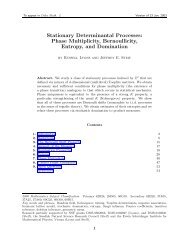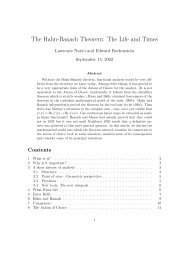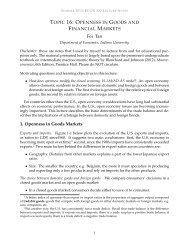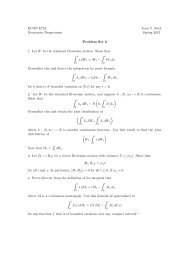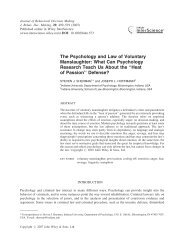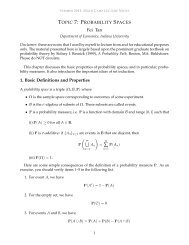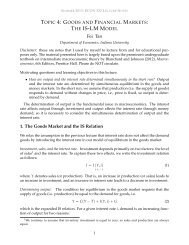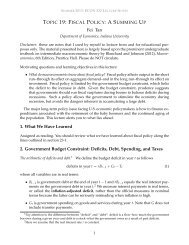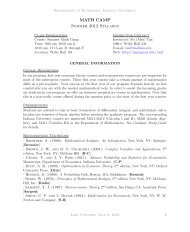Linear Difference Equations - Mypage
Linear Difference Equations - Mypage
Linear Difference Equations - Mypage
Create successful ePaper yourself
Turn your PDF publications into a flip-book with our unique Google optimized e-Paper software.
Chapter 8<br />
<strong>Linear</strong> <strong>Difference</strong> <strong>Equations</strong> and Lag<br />
Operators<br />
8.1 Lag Operators<br />
The backshift or lag operator is defined by<br />
Lxt = xt−1<br />
L n xt = xt−n for n = ...,−2,−1,0,1,2,....<br />
Multiplying a variable xt by L n thus gives the value of x shifted back n periods. Notice that if<br />
n < 0, the effect of multiplying xt byL n is to shift x forward in time by n periods.<br />
Consider polynomials in the lag operator given by<br />
A(L) = a0 +a1L+a2L 2 +··· =<br />
∞<br />
ajL j ,<br />
where the aj’s are constant and L 0 ≡ 1. Operating on xt withA(L) yields a moving sum of x ′ s:<br />
j=0<br />
A(L)xt = (a0 +a1L+a2L 2 +···)xt<br />
= a0xt +a1xt−1 +a2xt−2 +···<br />
∞<br />
= ajxt−j.<br />
j=0<br />
To take a simple example of a rational polynomial in L, consider<br />
A(L) =<br />
1<br />
1−λL = 1+λL+λ2 L 2 +··· , (8.1)<br />
which holds assuming the normal expansion for an infinite geometric series applies in this setting.<br />
Note that this can be verified by multiplying both sides of the equality by (1−λL). However, this<br />
result is only of practical use when|λ| < 1. To see why, consider the following infinite sum<br />
1<br />
1−λL xt =<br />
105<br />
∞<br />
j=0<br />
λ j xt−j,
A. W. Richter 8.2. FIRST-ORDER DIFFERENCE EQUATIONS<br />
for the case in which the path of xt is constant atx. Then,<br />
1<br />
1−λL xt = x<br />
∞<br />
λ j .<br />
and if |λ| > 1, we get that the above sum is unbounded. In some instances we need a solution for<br />
the case in which x is constant and we are looking infinitely far back in time. Thus, we impose<br />
the condition: |λ| < 1. It is quite useful to realize that we can use an alternative expansion for the<br />
geometric polynomial 1/(1 − λL). Formally, if the normal expansion for this infinite geometric<br />
series applies, then<br />
1<br />
1−λL<br />
Thus, operating on xt gives<br />
(−λL)−1 1<br />
= = −<br />
1−(λL) −1 λL<br />
= − 1<br />
λ L−1 −<br />
1<br />
1−λL xt = − 1<br />
λ xt+1 −<br />
1<br />
λ<br />
j=0<br />
2<br />
L −2 −<br />
<br />
1<br />
+ +···<br />
λL (λL) 2<br />
3 1<br />
L<br />
λ<br />
−3 −··· . (8.2)<br />
<br />
1+ 1<br />
2 1<br />
xt+2 −··· = −<br />
λ<br />
∞<br />
j=1<br />
j 1<br />
xt+j,<br />
λ<br />
which shows [1/(1 − λL)]xt to be a geometrically declining weighted sum of future values of x.<br />
Notice that for this infinite sum to be finite for a constant time path xt+j = x for all j and t, the<br />
series − ∞<br />
j=1 (1/λ)j must be convergent, which requires that |1/λ| < 1 or, equivalently, |λ| > 1.<br />
8.2 First-Order <strong>Difference</strong> <strong>Equations</strong><br />
A linear difference equation can be defined as an equation that relates the endogenous (determined<br />
within the model) variable yt to its previous values linearly. The simplest one is a first-order scalar<br />
linear difference equation such as<br />
yt = λyt−1 +bxt +a, (8.3)<br />
wherext is an exogenous (determined outside the model) variable andais a constant. This is a firstorder<br />
difference equation, since yt is dependent on only its first lag yt−1. Here, we are interested in<br />
finding a solution of yt in terms of current, past, or future values of the exogenous variable xt and<br />
(less importantly) the constant a. Put it different, we want to characterize the endogenous sequence<br />
yt in terms of the exogenous sequence xt.<br />
Using the lag operator defined above, we can rewrite (8.3) as follows:<br />
(1−λL)yt = bxt +a. (8.4)<br />
Operating on both sides of this equation by (1 − λL) −1 , we can obtain a particular solution for<br />
(8.4), denoted by ˆyt, as follows:<br />
ˆyt = bxt a<br />
+ . (8.5)<br />
1−λL 1−λ<br />
Note that since a is a constant, a/(1 − λL) = a/(1 − λ) irrespective of the size of |λ| (This can<br />
be verified by considering the expansion given in (8.1) when |λ| < 1 and the expansion given in<br />
106
A. W. Richter 8.2. FIRST-ORDER DIFFERENCE EQUATIONS<br />
(8.2) when |λ| > 1). In order to obtain the general solution, we need to add a term to (8.5). For this<br />
purpose, suppose that ˜y = ˆy +wt is also a solution to (8.4). Then, using the particular solution to<br />
(8.4), we obtain<br />
(1−λL)˜y = (1−λL)ˆy +wt −λwt−1<br />
= bxt +a+wt −λwt−1.<br />
Therefore, as long as wt = λwt−1, ˜yt is also a solution. Note that we can iterate on this condition<br />
to obtain<br />
wt = λwt−1 = λ 2 wt−2 = λ 3 wt−3 = ··· = λ t w0,<br />
where w0 ≡ c, an arbitrary initial value. Hence, the general solution to (8.3) is given by<br />
yt = bxt a<br />
+<br />
1−λL 1−λ +λtc ∞<br />
= b λ j xt−j + a<br />
1−λ +λtc, (8.6)<br />
j=0<br />
where c is an arbitrary constant. Notice that for yt, defined by (8.6), to be finite λ j xt−j must be<br />
small for large j. That is, we require<br />
lim<br />
n→∞<br />
j=n<br />
∞<br />
λ j xt−j = 0 for all t.<br />
For the case of xt−j = x for all j and t, the above condition requires |λ| < 1. Notice also that the<br />
infinite sum a ∞ i=0λj in (8.6) is also finite only if |λ| < 1, in which case it equals a/(1−λ) for<br />
a = 0 and 0 otherwise. Tentatively, assume that |λ| < 1.<br />
In order to analyze (8.6), rewrite the equation for t ≥ 1 as<br />
t−1<br />
yt = a λ j ∞<br />
+a λ j t−1<br />
+b<br />
j=0<br />
= a(1−λt )<br />
1−λ<br />
j=t<br />
= a(1−λt )<br />
1−λ +b<br />
t−1<br />
j=0<br />
aλt<br />
+<br />
1−λ +b<br />
t−1<br />
j=0<br />
j=0<br />
j=0<br />
λ j xt−j +λ t<br />
λ j xt−j +b<br />
∞<br />
j=t<br />
λ j xt−j +bλ t<br />
⎡<br />
λ j xt−j +λ t c<br />
∞<br />
j=0<br />
⎣ a<br />
1−λ +b<br />
λ j x0−j +λ t c<br />
∞<br />
j=0<br />
= a(1−λt )<br />
1−λ +b<br />
t−1<br />
λ j xt−j +λ t y0 (using (8.6))<br />
= a<br />
1−λ +λt<br />
<br />
y0 − a<br />
<br />
1−λ<br />
t−1<br />
+b λ j xt−j, t ≥ 1.<br />
j=0<br />
λ j x0−j +λ 0 c<br />
Consider the special case in which xt = 0 for all t. Under this condition, we obtain<br />
yt = a<br />
1−λ +λt<br />
<br />
y0 − a<br />
<br />
. (8.7)<br />
1−λ<br />
107<br />
⎤<br />
⎦
A. W. Richter 8.2. FIRST-ORDER DIFFERENCE EQUATIONS<br />
Notice that if the initial condition y0 = a/(1 −λ), then yt = y0. In the case, y is constant across<br />
all future time periods anda/(1−λ) is known as a stationary point. Moreover, it is easy to see that<br />
for |λ| < 1, the second term in (8.7) tends to zero and thus<br />
lim<br />
t→∞ yt = a<br />
1−λ .<br />
This shows that the system is stable, tending to approach the stationary value as time passes.<br />
The difference equation (8.4) can also be solved using the alternative representation of (1 −<br />
λL) −1 given in (8.2). Using this this result, the general solution is given by<br />
yt = (−λL)−1 (−λL)−1<br />
1−(λL) −1a+ 1−(λL) −1bxt +λ t c<br />
= a<br />
1−λ −b<br />
∞<br />
λ −j xt+j +λ t c. (8.8)<br />
j=1<br />
The equivalence of the solutions (8.6) and (8.8) will hold whenever<br />
b<br />
1−λL xt and<br />
(λL) −1<br />
1−(λL) −1bxt<br />
are both finite. However, it is often the case that one of these two conditions fails to hold. For<br />
example, if the sequence {xt} is bounded, this is sufficient to imply that {[b/(1 − λL)]xt} is a<br />
bounded sequence if |λ| < 1, but not sufficient to imply that<br />
(λL) −1<br />
1−(λL) −1bxt<br />
is a convergent sum for all t. Similarly, if |λ| > 1, boundedness of the sequence {xt} is sufficient<br />
to imply that<br />
<br />
(λL) −1<br />
1−(λL) −1bxt<br />
is a bounded sequence, but fails to guarantee finiteness of b/(1−λL)xt. In instances where one of<br />
b<br />
1−λL xt or<br />
(λL) −1<br />
1−(λL) −1bxt<br />
is always finite and the other is not, we shall take our solution to the first-order difference equation<br />
(8.4) as either (8.6), where the backward sum inxt is finite, or (8.8), where the forward sum inxt is<br />
finite. This procedure assures us that we shall find the unique solution of (8.4) that is finite for all t,<br />
provided that such a solution exists.<br />
If we want to guarantee that the sequence {yt} given by (8.6) or (8.8) is bounded for all t, it is<br />
evident that we must set c = 0. This is necessary since if λ > 1 and c > 0,<br />
while if λ < 1 and c > 0,<br />
lim<br />
t→∞ cλt = ∞,<br />
lim<br />
t→−∞ cλt = ∞.<br />
108
A. W. Richter 8.3. SECOND-ORDER DIFFERENCE EQUATIONS<br />
Thus, when|λ| < 1, the bounded sequenceyt from (8.6) can be obtained by following the backward<br />
representation with the initial condition c = 0 and is given by<br />
yt = b 1+λL+(λL) 2 +(λL) 3 +··· xt + a<br />
1−λ<br />
∞<br />
= b λ j xt−j + a<br />
1−λ .<br />
j=0<br />
On the other hand, when|λ| > 1, we need to use forward representation in order to get the bounded<br />
sequence yt as follows:<br />
yt = (−λL)−1<br />
1−(λL) −1bxt + (−λL)−1<br />
1−(λL) −1a<br />
∞<br />
= −b<br />
j=1<br />
λ −j xt+j + a<br />
1−λ ,<br />
again setting c = 0. In general, the convention is to solve stable roots (|λ| < 1) backward and<br />
unstable roots (|λ| > 1) forward.<br />
8.3 Second-Order <strong>Difference</strong> <strong>Equations</strong><br />
A second-order difference equation relates the endogenous variable yt to its previous two values,<br />
yt−1 and yt−2, linearly. Consider following second-order difference equation given by<br />
yt = φ1yt−1 +φ2yt−2 +bxt +a, (8.9)<br />
where xt is again an exogenous sequence of real numbers for t = ...,−1,0,1,.... Using the lag<br />
operator, we can write (8.9) as follows:<br />
(1−φ1L−φ2L 2 )yt = bxt +a.<br />
It is convenient to write the polynomial 1−φ1L−φ2L 2 in an alternative way, given by the factorization<br />
1−φ1L−φ2L 2 = (1−λ1L)(1−λ2L)<br />
= 1−(λ1 +λ2)L+λ1λ2L 2 ,<br />
whereλ1λ2 = −φ2 andλ1+λ2 = φ1. To see howλ1 andλ2 are related to the roots or zeros of the<br />
polynomial A(z) = 1−φ1z −φ2z2 , notice that<br />
<br />
1 1<br />
(1−λ1z)(1−λ2z) = λ1λ2 −z −z .<br />
λ1 λ2<br />
Note that we use a function of a number z (possibly complex) instead of the lag operator L since<br />
it does not really make much to talk about roots or zeros of a polynomial that is a function of a lag<br />
operator. If we set the above equation to zero in order to solve for its roots, it is clear that the equation<br />
is satisfied at the two rootsz1 = 1/λ1 andz2 = 1/λ2. Given the polynomialA(z) = 1−φ1z−φ2z 2 ,<br />
the roots 1/λ1 and 1/λ2 are found by solving the characteristic equation<br />
1−φ1z −φ2z 2 = 0<br />
109
A. W. Richter 8.3. SECOND-ORDER DIFFERENCE EQUATIONS<br />
for two values of z. Given that λi = z −1<br />
i for i = 1,2, multiplying the above equation byz −2 yields<br />
Applying the quadratic formula then gives<br />
z −2 −z −1 φ1 −φ2 = λ 2 −φ1λ−φ2 = 0.<br />
λi = φ1 ± φ2 1 +4φ2<br />
,<br />
2<br />
which enables us to obtain the reciprocals ofλ1 and λ2 for given values of φ1 and φ2.<br />
8.3.1 Distinct Real Eigenvalues<br />
General Solution<br />
When λ1 = λ2 and λi = 1 for all i, the second order difference equation (8.9) can be written as<br />
Thus, the general solution to (8.10) is given by<br />
yt =<br />
(1−λ1L)(1−λ2L)yt = bxt +a. (8.10)<br />
1<br />
(1−λ1L)(1−λ2L) bxt +<br />
where c1 and c2 are any constants that can be verified by noticing<br />
Particular Solution<br />
a<br />
(1−λ1)(1−λ2) +λt 1 c1 +λ t 2 c2, (8.11)<br />
(1−λ1L)(1−λ2L)c1λ t 1 = 0 and (1−λ1L)(1−λ2L)c2λ t 2<br />
= 0.<br />
If both eigenvalues are distinct as in (8.11), then the above coefficient can be written as<br />
j=0<br />
1<br />
(1−λ1L)(1−λ2L) =<br />
j=0<br />
j=0<br />
1<br />
λ1 −λ2<br />
<br />
λ1 λ2<br />
− . (8.12)<br />
1−λ1L 1−λ2L<br />
Thus, if either a = 0 or the magnitude of both eigenvalues is strictly less than unity (that is, if<br />
|λ1| < 1 and |λ2| < 1), (8.11) can be written as<br />
a<br />
yt =<br />
(1−λ1)(1−λ2) +<br />
<br />
1 λ1 λ2<br />
− bxt +λ<br />
λ1 −λ2 1−λ1L 1−λ2L<br />
t 1c1 +λ t 2c2 ∞<br />
= a λ j<br />
∞<br />
1 λ j<br />
∞ λ1b<br />
2 + λ<br />
λ1 −λ2<br />
j<br />
1xt−j − λ2b<br />
∞<br />
λ<br />
λ1 −λ2<br />
j<br />
2xt−j +λ t 1c1 +λ t 2c2 (8.13)<br />
provided that<br />
lim<br />
∞<br />
n→∞<br />
j=n<br />
j=0<br />
λ j<br />
i xt−j = 0, for all t<br />
fori = 1,2. Note that this stipulation is needed so that the corresponding geometric sums are finite.<br />
In order to analyze (8.13), let’s first consider the special case wherea = 0, so that this equation<br />
holds regardless of the magnitude ofλi. Then rewriting (8.13) for t ≥ 1 gives<br />
yt = λ1b t−1<br />
λ1 −λ2<br />
j=0<br />
λ j<br />
1xt−j − λ2b t−1<br />
λ1 −λ2<br />
110<br />
j=0<br />
λ j<br />
2 xt−j + λ1b<br />
λ1 −λ2<br />
∞<br />
j=t<br />
λ j<br />
1 xt−j
A. W. Richter 8.3. SECOND-ORDER DIFFERENCE EQUATIONS<br />
where<br />
θ0 ≡<br />
⎧<br />
⎨<br />
− λ2b<br />
λ1 −λ2<br />
∞<br />
j=t<br />
= λ1b t−1<br />
λ1 −λ2<br />
j=0<br />
⎩ c1 + λ1b<br />
λ1 −λ2<br />
λ j<br />
2 xt−j +λ t 1c1 +λ t 2c2<br />
λ j<br />
1xt−j − λ2b t−1<br />
λ1 −λ2<br />
∞<br />
λ j<br />
j=0<br />
1 x0−j<br />
⎫<br />
⎬<br />
j=0<br />
⎭ and η0 ≡<br />
Thus, for the case in which xt = 0 for t ≥ 1, we obtain<br />
λ j<br />
2 xt−j +λ t 1θ0 +λ t 2η0,<br />
⎧<br />
⎨<br />
⎩ c2 − λ2b<br />
λ1 −λ2<br />
∞<br />
λ j<br />
j=0<br />
2 x0−j<br />
⎫<br />
⎬<br />
⎭ .<br />
yt = λ t 1 θ0 +λ t 2 η0. (8.14)<br />
If θ0 = η0 = 0, then yt = 0 for all t ≥ 1, regardless of the values of λ1 and λ2. Thus, y = 0<br />
is the stationary point or long-run equilibrium value of (8.14). If λ1 and λ2 are real then limt→∞<br />
will equal its stationary point if and only if both |λ1| < 1 and |λ2| < 1. If one or both or the λ’s<br />
exceed one in absolute value, the behavior of y will eventually be dominated by the term in (8.14)<br />
associated with the λ that is larger in absolute value.<br />
Now let’s return to the more general case. If we are interested in a bounded sequence {yt}<br />
mapped from a bounded sequence {xt}, then we need to set both of the constants c1 and c2 to zero,<br />
and focus on the associated particular solution. If the magnitudes of both eigenvalues are strictly<br />
less than unity, that is, if |λ1| < 1 and |λ2| < 1, then the bounded solution to (8.9) is given by<br />
yt =<br />
a λ1b<br />
+<br />
(1−λ1)(1−λ2) λ1 −λ2<br />
∞<br />
j=0<br />
λ j<br />
1 xt−j − λ2b<br />
λ1 −λ2<br />
∞<br />
j=0<br />
λ j<br />
2 xt−j.<br />
If, without loss of generality, |λ1| < 1 and |λ2| > 1, then we can write<br />
1<br />
(1−λ1L)(1−λ2L) =<br />
<br />
1 λ1<br />
λ1 −λ2 1−λ1L +<br />
L−1 1−(λ2L) −1<br />
<br />
= λ1<br />
∞<br />
(λ1L)<br />
λ1 −λ2<br />
j + λ2<br />
∞<br />
(λ2L)<br />
λ1 −λ2<br />
−j .<br />
j=0<br />
Thus, in this case, the bounded solution to (8.9) is given by<br />
∞<br />
a λ1b<br />
yt = +<br />
(1−λ1)(1−λ2) λ1 −λ2<br />
j=0<br />
λ j<br />
1 xt−j + λ2b<br />
λ1 −λ2<br />
j=1<br />
∞<br />
j=1<br />
λ −j<br />
2 xt+j.<br />
Finally, if |λ1| > 1 and |λ2| > 1, then we can write<br />
1<br />
(1−λ1L)(1−λ2L) =<br />
<br />
1 −L−1 L<br />
+<br />
λ1 −λ2 1−(λ1L) −1 −1<br />
1−(λ2L) −1<br />
<br />
= − λ1<br />
∞<br />
(λ1L)<br />
λ1 −λ2<br />
−j + λ2<br />
∞<br />
(λ2L)<br />
λ1 −λ2<br />
−j .<br />
Therefore, in this final case, the bounded solution to (8.9) is given by<br />
∞<br />
a λ1b<br />
yt = −<br />
(1−λ1)(1−λ2) λ1 −λ2<br />
j=1<br />
j=1<br />
111<br />
λ −j<br />
1 xt+j + λ2b<br />
λ1 −λ2<br />
j=1<br />
∞<br />
j=1<br />
λ −j<br />
2 xt+j.
A. W. Richter 8.3. SECOND-ORDER DIFFERENCE EQUATIONS<br />
8.3.2 Complex Eigenvalues<br />
Recall that if one eigenvalue turns out to be a complex number, then the other eigenvalue is its<br />
complex conjugate. That is, ifλ1 = α+iβ, then λ2 = α−iβ, where<br />
λ1 +λ2 = 2α = φ1, λ1λ2 = α 2 +β 2 = −φ2, |λi| = α 2 +β 2 ∀i.<br />
Moreover, using the useful polar representation defined in section 7.2, we have<br />
λ1 = re iw = r(cosw+isinw), λ2 = re −iw = r(cosw−isinw),<br />
where r = α 2 +β 2 and tanw = β/α. Finally notice that<br />
λ1 +λ2 = r(e iw +e −iw ) = 2rcosw and λ1 −λ2 = r(e iw −e −iw ) = 2risinw.<br />
Returning to the special case where a = 0 and xt = 0, when the eigenvalues are complex, (8.14),<br />
becomes<br />
yt = θ0(re iw ) t +η0(re −iw ) t<br />
= θ0(r t e iwt )+η0(r t e −iwt )<br />
= θ0r t [coswt+isinwt]+η0r t [coswt−isinwt]<br />
= (θ0 +η0)r t coswt+i(θ0 −η0)r t sinwt.<br />
Since yt must be a real number for all t, it follows that θ0 + η0 must be real and θ0 − η0 must be<br />
imaginary. Therefore, θ0 and η0 must be complex conjugates, say θ0 = pe iθ and η0 = pe −iθ . Thus,<br />
we can write<br />
yt = pe iθ r t e iwt +pe −iθ r t e −iwt = pr t [e i(wt+θ) +e −i(wt+θ) ]<br />
= pr t [cos(wt+θ)+isin(wt+θ)<br />
+cos(−(wt+θ))+isin(−(wt+θ))]<br />
= 2pr t cos(wt+θ),<br />
where we have made use of the fact that cos is an even function and sin is an odd function (i.e.<br />
for any input x, cos(x) = cos(−x) and sin(−x) = −sin(x)). The path of yt oscillates with a<br />
frequency determined by w. The dampening factor, r t , is determined by the amplitude, r, of the<br />
complex roots. When r < 1, the stationary point of the difference equation, yt = 0, is approached<br />
as t → ∞. Moreover, as long as w = 0, the system displays damped oscillations. If r = 1, yt<br />
displays repeated oscillations of unchanging amplitude and the solution is periodic. If r > 1 the<br />
path ofyt displays explosive oscillations, unless the initial conditions are say, y0 = 0 andy1 = 0 so<br />
that y starts out at the stationary point for two successive values.<br />
Now if we once again consider the more general case where we are interested in a bounded<br />
sequence {yt} mapped from a bounded sequence {xt}, we need to set both of the constants c1<br />
and c2 to zero, and focus on the associated particular solution. If we note that moduli of complex<br />
eigenvalues are same, then when |λ| < 1, we can write<br />
1 λ1<br />
=<br />
(1−λ1L)(1−λ2L) λ1 −λ2<br />
=<br />
1<br />
∞<br />
(λ1L) j − λ2<br />
j=0<br />
∞<br />
λ1 −λ2 j=0<br />
112<br />
∞<br />
(λ2L)<br />
λ1 −λ2 j=0<br />
j<br />
<br />
λ j+1<br />
1 −λj+1<br />
<br />
2 L j
A. W. Richter 8.3. SECOND-ORDER DIFFERENCE EQUATIONS<br />
=<br />
=<br />
=<br />
1<br />
re iw −re −iw<br />
1<br />
2risinw<br />
∞ iw j+1 −iw j+1<br />
(re ) −(re ) L j<br />
j=0<br />
∞<br />
2r j+1 isin[w(j +1)]L j<br />
j=0<br />
∞<br />
r<br />
jsin[w(j +1)]<br />
L<br />
sinw<br />
j .<br />
j=0<br />
Thus, the bounded solution to (8.9) is given by<br />
yt = a<br />
∞<br />
j=0<br />
r<br />
jsin[w(j +1)]<br />
sinw<br />
If, on the other hand, |λ| > 1, we can write<br />
1 λ1<br />
= −<br />
(1−λ1L)(1−λ2L) λ1 −λ2<br />
= − 1<br />
λ1 −λ2<br />
= −<br />
∞<br />
j=0<br />
+b<br />
∞<br />
∞<br />
r<br />
jsin[w(j +1)]<br />
sinw<br />
j=0<br />
xt−j.<br />
(λ1L)<br />
j=1<br />
−j + λ2<br />
λ1 −λ2 j=1<br />
∞<br />
j=0<br />
<br />
λ −j<br />
1 −λ−j<br />
<br />
2 L −(j+1)<br />
r −(j+1)sin(wj)<br />
sinw L−(j+1) .<br />
Thus, in this case, the bounded solution to (8.9) is given by<br />
yt = −a<br />
∞<br />
j=0<br />
r −(j+1)sin(wj)<br />
sinw −b<br />
∞<br />
j=0<br />
8.3.3 Stability Conditions for Distinct Eigenvalues<br />
Recall that the roots of (8.9) are given by<br />
λi = φ1 ± φ2 1 +4φ2<br />
.<br />
2<br />
For the roots to be complex, the discriminant must be negative, i.e.,<br />
φ 2 1 +4φ2 < 0,<br />
∞<br />
(λ2L) −j<br />
r −(j+1)sin(wj)<br />
sinw xt+j+1.<br />
which implies that φ2 is negative. When the above condition is satisfied, the roots are given by<br />
λ1 = φ1<br />
2 +i<br />
<br />
−(φ2 1 +4φ2)<br />
≡ a+ib, λ2 =<br />
2<br />
φ1<br />
2 −i<br />
<br />
−(φ2 1 +4φ2)<br />
≡ a−ib.<br />
2<br />
Once again, recall that in polar form<br />
a+ib = r[cosw +isinw] = re iw ,<br />
113
A. W. Richter 8.3. SECOND-ORDER DIFFERENCE EQUATIONS<br />
Figure 8.1: Second Order <strong>Difference</strong> Equation: Regions of Stability<br />
where r ≡ √ a2 +b2 and tanw = β/α. Thus we have that<br />
<br />
φ12<br />
r = −<br />
2<br />
(φ21 +4φ2)<br />
=<br />
4<br />
−φ2.<br />
For the oscillations to be damped, meaning that in the long-run the difference equation will be<br />
stable, we require that r = √ −φ2 < 1, which requires that φ2 > −1.<br />
If the roots are real, the difference equation will be stable if both roots are less that one in<br />
magnitude. This requires<br />
−1 < φ1 + φ 2 1 +4φ2<br />
2<br />
< 1 and −1 < φ1 − φ 2 1 +4φ2<br />
2<br />
Note that it is sufficient to find conditions such that statement on the left hand side is less than unity<br />
while the condition on the right hand side is greater than minus one. The former condition requires<br />
<br />
1<br />
φ1 + φ<br />
2<br />
2 1 +4φ2<br />
<br />
< 1 → φ2 1 +4φ2 < 2−φ1<br />
The latter condition requires<br />
→ φ 2 1 +4φ2 < 4+φ 2 1 −4φ1 → φ1 +φ2 < 1.<br />
1<br />
2<br />
<br />
φ 2 1 +4φ2 −φ1<br />
<br />
< 1 →<br />
<br />
φ 2 1 +4φ2 < 2+φ1<br />
→ φ 2 1 +4φ2 < 4+φ 2 1 +4φ1 → φ2 −φ1 < 1.<br />
Therefore, when φ2 > −1, φ1 +φ2 < 1, and φ2 − φ1 < 1 hold, the roots, regardless of whether<br />
they are real (φ 2 1 +4φ2 ≥ 0) or complex (φ 2 1 +4φ2 < 0), will yield a stable second order difference<br />
equation. The following figure summarizes these results.<br />
114<br />
< 1.
A. W. Richter 8.3. SECOND-ORDER DIFFERENCE EQUATIONS<br />
8.3.4 Repeated Real Eigenvalues<br />
General Solution<br />
When λ1 = λ2 ≡ λ and λi = 1 for all i, the second order difference equation (8.9) becomes<br />
Thus, the general solution to (8.15) is given by<br />
yt =<br />
where c1 and c2 are constants. To see this note that<br />
Particular Solution<br />
(1−λL) 2 yt = bxt +a. (8.15)<br />
1<br />
(1−λL) 2bxt a<br />
+<br />
(1−λL) 2 +λtc1 +tλ t c2, (8.16)<br />
(1−λL) 2 (λ t c1 +tλ t c2) = 0.<br />
If we are interested in a bounded sequence {yt} mapped from a bounded sequence {xt}, then we<br />
need to set both of the constants c1 and c2 to zero, and focus on the associated particular solution.<br />
When λ1 = λ2 ≡ λ and |λ| < 1, we can show that<br />
∞<br />
(λL) j+1 = λL<br />
1−λL .<br />
j=0<br />
Applying the derivative trick from Example 1.1.28 gives<br />
1<br />
(1−λ1L)(1−λ2L) =<br />
1<br />
=<br />
(1−λL) 2<br />
Thus, in this case, the bounded solution to (8.9) is given by<br />
yt =<br />
a<br />
+b<br />
(1−λL) 2<br />
If, on the other hand, |λ| > 1, we can show that<br />
1<br />
1−λL<br />
Applying the derivative trick yields<br />
= −(λL)<br />
1−(λL)<br />
1<br />
=<br />
(1−λL) 2<br />
∞<br />
(j +1)(λL) j .<br />
j=0<br />
∞<br />
(j +1)λ j xt−j.<br />
j=0<br />
−1 = −<br />
∞<br />
(λL) −(j+1) .<br />
j=0<br />
∞<br />
(j +1)(λL) −(j+2) .<br />
j=0<br />
Thus, in this case, the bounded solution to (8.9) is given by<br />
yt =<br />
a<br />
+b<br />
(1−λL) 2<br />
∞<br />
j=0<br />
(j +1)(λ) −(j+2) xt+j+2.<br />
115
A. W. Richter 8.4. SYSTEMS OF LINEAR DIFFERENCE EQUATIONS<br />
8.4 Systems of <strong>Linear</strong> <strong>Difference</strong> <strong>Equations</strong><br />
8.4.1 Solution Technique with Real Eigenvalues<br />
Consider the following k-dimensional system of equations:<br />
zt+1 = Azt,<br />
withz ∈ R k andA ∈ R k×k . Letλ1,λ2,...,λk be the eigenvalues ofAand letv1,v2,...,vk ∈ R k<br />
be the corresponding eigenvectors. Then the projection matrix P = [v1,v2,...,vk] and<br />
AP = [Av1,Av2,...,Avk]<br />
= [λ1v1,λ2v2,...,λkvk]<br />
⎡ ⎤<br />
λ1 0 ··· 0<br />
⎢ 0 λ2 ··· 0 ⎥<br />
= [v1,v2,...,vk] ⎢<br />
⎣<br />
.<br />
. . ..<br />
⎥<br />
. ⎦<br />
0 0 ··· λk<br />
⎡ ⎤<br />
λ1 0 ··· 0<br />
⎢ 0 λ2 ··· 0 ⎥<br />
= P ⎢<br />
⎣<br />
.<br />
. . ..<br />
⎥<br />
. ⎦<br />
0 0 ··· λk<br />
If P is invertible we can obtain:<br />
P −1 ⎡ ⎤<br />
λ1 0 ··· 0<br />
⎢ 0 λ2 ··· 0 ⎥<br />
AP = ⎢<br />
⎣<br />
.<br />
. . ..<br />
⎥<br />
. ⎦<br />
0 0 ··· λk<br />
withλ1,λ2,...,λk be distinct. Now we want to solve:<br />
zt+1 = Azt.<br />
(8.17)<br />
We can go through the following steps: First multiply the above equation by P −1 and use equation<br />
(8.17) to obtain<br />
P −1 zt+1 = P −1 Azt<br />
=<br />
⎡ ⎤<br />
λ1 0 ··· 0<br />
⎢ 0 λ2 ··· 0 ⎥<br />
⎢<br />
⎣<br />
.<br />
. . ..<br />
⎥<br />
. ⎦<br />
0 0 ··· λk<br />
P−1zt. Then, if we define Z = P−1z, we get the following decoupled system:<br />
⎡ ⎤<br />
λ1 0 ··· 0<br />
⎢ 0 λ2 ··· 0 ⎥<br />
Zt+1 = ⎢<br />
⎣<br />
.<br />
. . ..<br />
⎥<br />
. ⎦<br />
0 0 ··· λk<br />
Zt,<br />
116
A. W. Richter 8.4. SYSTEMS OF LINEAR DIFFERENCE EQUATIONS<br />
which, expanded out, can be written as:<br />
⎡ ⎤<br />
Z1,t+1<br />
⎢ Z2,t+1<br />
⎥<br />
⎢ ⎥<br />
⎣ . ⎦<br />
Zk,t+1<br />
=<br />
⎡ ⎤⎡<br />
λ1 0 ··· 0<br />
⎢ 0 λ2 ··· 0 ⎥⎢<br />
⎥⎢<br />
⎢<br />
⎣<br />
.<br />
. . ..<br />
⎥⎢<br />
. ⎦⎣<br />
0 0 ··· λk<br />
Z1,t<br />
Z2,t<br />
.<br />
Zk,t<br />
⎤<br />
⎥<br />
⎥.<br />
(8.18)<br />
⎦<br />
The above form represents k separate difference equations that can be recursively solved to obtain<br />
Z1,t+1 = λ1Z1,t = λ 2 1Z1,t−1 = ··· = λ t+1<br />
1 Z1,0<br />
Z2,t+1 = λ2Z2,t = λ 2 2Z2,t−1 = ··· = λ t+1<br />
2 Z2,0<br />
.<br />
Zk,t+1 = λkZk,t = λ 2 k Zk,t−1 = ··· = λ t+1<br />
k Zk,0,<br />
which, in matrix form, can be represented as<br />
⎡ ⎤<br />
Z1,t+1<br />
⎢ Z2,t+1<br />
⎥<br />
⎢ ⎥<br />
⎣ . ⎦<br />
Zk,t+1<br />
=<br />
⎡<br />
λ<br />
⎢<br />
⎣<br />
t+1<br />
1 0 ···<br />
0 λ<br />
0<br />
t+1<br />
2 ···<br />
.<br />
. . ..<br />
0<br />
.<br />
0 0 ··· λ t+1<br />
⎤⎡<br />
⎥⎢<br />
⎥⎢<br />
⎥⎢<br />
⎦⎣<br />
k<br />
Moreover, since z ≡ PZ, the above system can be written as<br />
⎡ ⎤ ⎡<br />
Z1,t+1 λ<br />
⎢ Z2,t+1<br />
⎥ ⎢<br />
⎥ ⎢<br />
P ⎢ ⎥ = P ⎢<br />
⎣ . ⎦ ⎣<br />
Zk,t+1<br />
t+1<br />
1 0 ···<br />
0 λ<br />
0<br />
t+1<br />
2 ···<br />
.<br />
. . ..<br />
0<br />
.<br />
0 0 ··· λ t+1<br />
k<br />
⎡ ⎤ ⎡<br />
z1,t+1 λ<br />
⎢ z2,t+1<br />
⎥ ⎢<br />
⎥ ⎢<br />
⎢ ⎥ = P ⎢<br />
⎣ . ⎦ ⎣<br />
zk,t+1<br />
t+1<br />
1 0 ··· 0<br />
0 λ t+1<br />
2 ··· 0<br />
.<br />
. . .. .<br />
0 0 ··· λ t+1<br />
k<br />
If we define diag(λ1,...,λt) = D, we obtain<br />
zt+1 = PD t+1 P −1 z0.<br />
Alternatively we can use (8.19) to express the solution as<br />
⎡ ⎤ ⎡<br />
⎢<br />
⎣<br />
Z1,t+1<br />
Z2,t+1<br />
.<br />
Zk,t+1<br />
⎥<br />
⎦ =<br />
⎢<br />
⎣<br />
λ t+1<br />
1 c1<br />
λ t+1<br />
2 c2<br />
.<br />
λ t+1<br />
k ck<br />
⎤<br />
Z1,0<br />
Z2,0<br />
.<br />
Zk,0<br />
⎤<br />
⎥<br />
⎦ P−1 ⎢<br />
P ⎢<br />
⎣<br />
⎤<br />
⎥<br />
⎦ P−1<br />
⎡<br />
⎢<br />
⎣<br />
⎥<br />
⎥.<br />
(8.19)<br />
⎦<br />
which, if we multiply both sides of the above result by the projection matrix P , implies<br />
⎡ ⎤<br />
⎢<br />
zt+1 = [v1,v2,...vk] ⎢<br />
⎣<br />
117<br />
λ t+1<br />
1 c1<br />
λ t+1<br />
2 c2<br />
.<br />
λ t+1<br />
k ck<br />
⎥<br />
⎦<br />
⎤<br />
⎥<br />
⎦ ,<br />
⎡<br />
z1,0<br />
z2,0<br />
.<br />
zk,0<br />
Z1,0<br />
Z2,0<br />
.<br />
Zk,0<br />
⎤<br />
⎥<br />
⎦ .<br />
⎤<br />
⎥<br />
⎦
A. W. Richter 8.4. SYSTEMS OF LINEAR DIFFERENCE EQUATIONS<br />
= v1λ t+1<br />
1 c1 +v2λ t+1<br />
2 c2 +···+vkλ t+1<br />
k ck,<br />
where vk ∈ R k represents the kth eigenvector and the constant ck ≡ Zk,0 = P −1 zk,0. The<br />
following theorem summarizes this alternative approach.<br />
Theorem 8.4.1 (<strong>Difference</strong> Equation with Real Roots). Let A be a k × k matrix with k distinct<br />
real eigenvalues λ1,...,λk and corresponding eigenvectors v1,...,vk. The general solution of<br />
the system of difference equations is<br />
zt+1 = v1λ t+1<br />
1 c1 +v2λ t+1<br />
2 c2 +···+vkλ t+1<br />
k ck. (8.20)<br />
Remark 8.4.1. Consider a system of two linear difference equations<br />
or, in matrix form,<br />
zt+1 ≡<br />
xt+1 = axt +byt<br />
xt+1<br />
yt+1 = cxt +dyt<br />
yt+1<br />
<br />
=<br />
a b<br />
c d<br />
If b = c = 0 in these equations, they are uncoupled:<br />
xt+1 = axt<br />
yt+1 = dyt<br />
xt<br />
yt<br />
<br />
≡ Azt.<br />
and are easily solved as two separate one-dimensional problems:<br />
xt = a t x0 and yt = d t y0.<br />
When the equations are coupled (b = 0 or c = 0), the technique for solving the system is to find<br />
a change of variables that decouples these equations. This is precisely the role of eigenvalues and<br />
eigenvectors.<br />
Example 8.4.1. Consider the following coupled system of difference equations<br />
or, in matrix form,<br />
zt+1 ≡<br />
xt+1<br />
yt+1<br />
To find the eigenvalues solve the following<br />
xt+1 = xt +4yt<br />
yt+1 = 0.5xt<br />
<br />
=<br />
1 4<br />
0.5 0<br />
xt<br />
yt<br />
<br />
≡ Azt.<br />
|A−λI| = (λ−2)(λ+1) set<br />
= 0,<br />
which implies that λ1 = 2 and λ2 = −1 are the the eigenvalues to this system. To find the<br />
corresponding eigenvectors, row-reduce A−2I and A+I to obtain the following equations<br />
xt = 4yt<br />
2xt = −4yt.<br />
Normalizing yt to 1, we get the following basis vectors that form the relevant projection matrix<br />
<br />
4 −2<br />
P = .<br />
1 1<br />
118
A. W. Richter 8.4. SYSTEMS OF LINEAR DIFFERENCE EQUATIONS<br />
Applying the change of variables Z = P −1 z to the original difference equation, we obtain<br />
Zt+1 = (P −1 AP)Zt<br />
<br />
λ1 0<br />
=<br />
0 λ2<br />
<br />
2t 0<br />
=<br />
0 (−1) t<br />
Zt =<br />
Thus, if we reapply the change of variables, we have<br />
<br />
xt<br />
= c12 t<br />
<br />
4<br />
1<br />
yt<br />
c1<br />
c2<br />
+c2(−1) t<br />
<br />
λt 1 0<br />
0 λt 2<br />
<br />
.<br />
Z0<br />
<br />
−2<br />
,<br />
1<br />
which is the same equation that we would have arrived at had we applied Theorem 8.4.1.<br />
8.4.2 Solution Technique with Complex Eigenvalues<br />
Consider the following two-dimensional system of equations<br />
zt+1 = Azt,<br />
where A is a 2 × 2 matrix with complex eigenvalues α ± iβ. Applying the change of variables<br />
z = PZ to the above difference equation yields<br />
PZt+1 = APZt → Zt+1 = P −1 APZt.<br />
SinceAis assumed to have complex eigenvalues, it has corresponding complex eigenvectors w1 =<br />
u+iv and w2 = u−iv. Thus, the projection matrix is given by<br />
P = [w1,w2] = [u+iv,u−iv].<br />
Moreover, using equation (8.17), it then follows that<br />
P −1 <br />
λ1 0 α+iβ 0<br />
AP = = .<br />
0 α−iβ<br />
Thus, the decoupled system becomes<br />
Recursive substitution then yields<br />
<br />
Xt+1<br />
Zt+1 ≡<br />
Yt+1<br />
0 λ2<br />
<br />
=<br />
α+iβ 0<br />
0 α−iβ<br />
Xt = k1(α+iβ) t<br />
Yt = k2(α−iβ) t ,<br />
Xt<br />
where the constant K ≡ [k1,k2] T = Z0 = P −1 z0 could be real or complex. Using the fact that<br />
zt = PZt, we can transforming transform the variables into their original form to obtain<br />
zt =<br />
xt<br />
yt<br />
<br />
Yt<br />
<br />
k1(α+iβ)<br />
= [u+iv,u−iv]<br />
t<br />
k2(α−iβ) t<br />
= k1(α+iβ) t (u+iv)+k2(α−iβ) t (u−iv). (8.21)<br />
119<br />
<br />
.
A. W. Richter 8.4. SYSTEMS OF LINEAR DIFFERENCE EQUATIONS<br />
Notice that this solution takes the same form as (8.20), except with complex eigenvalues and eigenvectors<br />
replacing the real eigenvectors and eigenvalues.<br />
Since the original problem contained only real numbers, we would like to find a solution that<br />
contains only real numbers. Since every solution of the system is contained in equation (8.21) for<br />
different choices of K = [k1,k2] T , we want to know if we can find parameters k1 and k2 so that<br />
equation (8.21) is real.<br />
Notice that except for the constant factors, the first term in equation (8.21) is the complex<br />
conjugate of the second. Since the sum of any complex number and its conjugate is the real number<br />
2α, we want to choose the first constant, k1, to be any complex constant c1 +ic2 and let the second<br />
constant, k2, be its conjugate pair, c1 −ic2. Then the first and second term in (8.21) turn out to be<br />
complex conjugates and the sum of them will be a real solution given by<br />
zt = (c1 +ic2)(α+iβ) t (u+iv)+(c1 −ic2)(α−iβ) t (u−iv)<br />
= 2Re (c1 +ic2)(α+iβ) t (u+iv) . (8.22)<br />
Applying Demoivre’s Formula (7.2), the above result can be written as<br />
z = 2Re (c1 +ic2)r t [cos(tθ)+isin(tθ)](u+iv) <br />
= 2r t Re{[(c1cos(tθ)−c2sin(tθ))+i(c2cos(tθ)+c1sin(tθ))](u+iv)}<br />
= 2r t [(c1cos(tθ)−c2sin(tθ))u−(c2cos(tθ)+c1sin(tθ))v],<br />
which is now a real solution.<br />
Theorem 8.4.2. Let A be a 2 × 2 matrix with complex eigenvalues α∗ ± iβ∗ and corresponding<br />
eigenvectors u∗ ±iv∗ . Write eigenvalues in polar coordinates asr∗ [cos(θ∗ )+isin(θ ∗ )], where<br />
r ∗ <br />
= (α∗ ) 2 +(β∗ ) 2 and (cos(θ ∗ ),sin(θ ∗ <br />
α∗ )) = .<br />
Then the general solution of the difference equation zt+1 = Azt is<br />
β∗<br />
r∗, r∗ zt = (r ∗ ) t [(c1cos(tθ ∗ )−c2sin(tθ ∗ ))u ∗ −(c2cos(tθ ∗ )+c1sin(tθ ∗ ))v ∗ ].<br />
Example 8.4.2. In Example 7.3.1, we found that the eigenvalues of<br />
<br />
1 1<br />
A =<br />
−9 1<br />
are 1±3i with corresponding eigenvectors<br />
1<br />
0<br />
<br />
0<br />
±i<br />
3<br />
In polar coordinates, the eigenvalues become<br />
1+3i = √ <br />
1<br />
10 √10 +i 3<br />
<br />
√ =<br />
10<br />
√ 10(cosθ ∗ +isinθ ∗ ),<br />
where θ∗ <br />
1 = arccos √10 ≈ 71.565◦ or 1.249 radians. The general solution for the system<br />
zt+1 ≡<br />
xt+1<br />
xt+1<br />
<br />
=<br />
120<br />
<br />
.<br />
1 1<br />
−9 1<br />
xt<br />
xt
A. W. Richter 8.4. SYSTEMS OF LINEAR DIFFERENCE EQUATIONS<br />
is given by<br />
<br />
xt<br />
yt<br />
= ( √ 10) t<br />
<br />
(c1cos(tθ ∗ )−c2sin(tθ ∗ <br />
1<br />
))<br />
0<br />
= ( √ 10) t<br />
<br />
c1cos(tθ∗ )−c2sin(tθ ∗ )<br />
−3c2cos(tθ∗ )−3c1sin(tθ ∗ <br />
.<br />
)<br />
−(c2cos(tθ ∗ )+c1sin(tθ ∗ ))<br />
<br />
0<br />
3<br />
Remark 8.4.2. In higher dimensions, a given matrix can have both real and complex eigenvalues.<br />
The solution of the corresponding system of difference equations is the obvious combination of the<br />
solutions described in Equation 8.4.1 and Theorem 8.4.2.<br />
121



